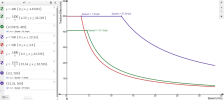Yes would agree entirely. First Co-Co bi-mode in the UK suitable for heavy freight on both diesel and electric over more than 'last mile' distance.
Either next week or the week after yes - overnight moves on the WCML. Gather they will be hauled from Leicester to Crewe.
I dont know the exact reason, but there is a situation north of Crewe (Possibly Warrington) where two modern powerful electrics (such as Stadler locos) in the same power section can cause issues if on full power. In essence if there is an '88' path north or south at the same time in that power section, the GBRf electric path for a 99 may only be available if they switch to diesel for a period, to avoid power problems. I know with the 93s if they run in multiple on electric, the software automatically downgrades the output to within safe limits.
I know when they did the 93 testing, ROG had to arrange with DRS to downgrade the power output of an 88 for a specific section on one path (or DRS had to run their path slightly earlier or later to avoid the power problems). In essence two 4MW electrics (whether in multi or separate workings) in the same power section, have the potential to pull 8MW of power, which exceeds the maximum, so by downgrading the output, so that combined they can still only pull the maximum which I think is around 6.8MW (dont quote me) avoids any issues.
It is 98% complete! First revenue earning train before the end of the year according to GBRf.

